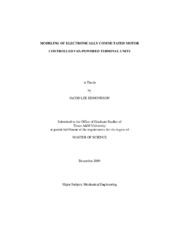| dc.description.abstract | Empirical models of airflow and power consumption were developed for series
and parallel variable air volume fan powered terminal units (FPTUs). An experimental
setup and test procedure were developed to test the terminal units over typical operating
ranges. The terminal units in this study used either an 8 in. (20.32 cm) or a 12 in. (30.48
cm) primary air inlet. All terminal units utilized electronically commutated motor
(ECM) controllers. Data collected were compared against previous data collected for
silicon controlled rectifier (SCR) units. Generalized models were developed for both
series and parallel units, and compared against models developed for SCR units.
In addition to the performance modeling, power factor and power quality data
were also collected for each terminal unit. The power quality analysis included
recording and analyzing harmonic distortion for current, voltage, and power up to the
25th harmonic. The total harmonic distortion (THD) was also recorded and presented.
For the series terminal units, models were developed for fan airflow, fan power,
and primary airflow. The models for fan airflow all had R2 values above 0.987. The models for fan power all had R2 values above 0.968. The models for primary airflow all
had R2 values above 0.895.
For the parallel terminal units, models were developed for leakage, fan airflow,
fan power, and primary airflow. All of the leakage models had R2 values above 0.826.
All of the fan airflow models had R2 values above 0.955. All of the fan power models
had R2 values above 0.922. All of the primary airflow models had R2 values above
0.872.
The real power THD was below 1.5 percent for both series and parallel FPTUs. The
current THD ranged from 84 percent to 172 percent for series FPTUs and from 83 percent to 183 percent for
parallel FPTUs. The voltage THD was below 1.4 percent for both series and parallel FPTUs.
The performance models developed will help improve the accuracy of building
energy simulation programs for heating, ventilation, and air conditioning (HVAC)
systems utilizing ECM controlled FPTUs. Increasing the accuracy of these simulations
will allow HVAC system designers to better optimize their designs for specific building
types in a wide variety of climates. | en |


